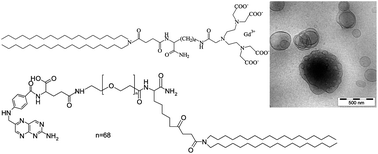Nanostructures based on monoolein or diolein and amphiphilic gadolinium complexes as MRI contrast agents†
Abstract
Highly ordered two or three dimensional mesophases in aqueous solution could be usefully obtained by using

* Corresponding authors
a
CIRPeB, Department of Pharmacy & IBB CNR, University of Naples “Federico II”, Via Mezzocannone, 16 80134 Napoli, Italy
E-mail:
gmorelli@unina.it
b Department of Chemistry I.F.M. & Molecular Imaging Centre, University of Turin, Via Nizza, 52, 10125 Turin, Italy
c Department of Pharmaceutical Technology and Biopharmacy, University of Freiburg, Hermann-Herder-Str. 9, D-70104 Freiburg, Germany
Highly ordered two or three dimensional mesophases in aqueous solution could be usefully obtained by using

 Please wait while we load your content...
Something went wrong. Try again?
Please wait while we load your content...
Something went wrong. Try again?
A. Accardo, E. Gianolio, F. Arena, S. Barnert, R. Schubert, D. Tesauro and G. Morelli, J. Mater. Chem. B, 2013, 1, 617 DOI: 10.1039/C2TB00329E
To request permission to reproduce material from this article, please go to the Copyright Clearance Center request page.
If you are an author contributing to an RSC publication, you do not need to request permission provided correct acknowledgement is given.
If you are the author of this article, you do not need to request permission to reproduce figures and diagrams provided correct acknowledgement is given. If you want to reproduce the whole article in a third-party publication (excluding your thesis/dissertation for which permission is not required) please go to the Copyright Clearance Center request page.
Read more about how to correctly acknowledge RSC content.
 Fetching data from CrossRef.
Fetching data from CrossRef.
This may take some time to load.
Loading related content
